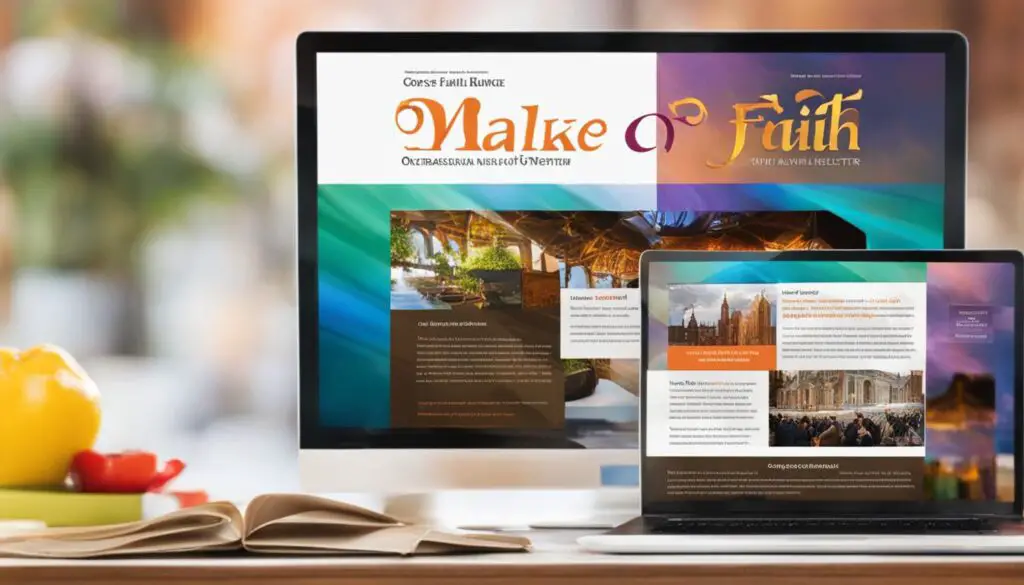In today’s digital age, effective communication is essential for churches looking to connect with their audience and spread their message of faith. Email newsletters have emerged as a powerful tool in evangelism, allowing churches to engage, inspire, and grow their spiritual community through digital communication. By leveraging the power of email marketing, churches can optimize their outreach efforts and reach individuals where they are actively seeking spiritual guidance.
With email newsletters, churches can build meaningful connections with their audience by delivering personalized content that resonates with individuals on their spiritual journey. These newsletters provide a platform to share stories of transformation, deliver uplifting messages, and provide valuable resources and opportunities for engagement and growth. By incorporating multimedia elements, such as videos and images, churches can create an immersive and impactful experience for their readers.
Moreover, email newsletters enable churches to tailor their communication based on specific demographics or interests, allowing them to effectively target their messaging to the right audience. By segmenting their subscriber list and crafting compelling subject lines, churches can increase open rates and ensure that their newsletters are seen and read by their intended recipients. Additionally, by tracking and analyzing newsletter performance, churches can gain valuable insights into their audience’s engagement, allowing them to refine their strategies and maximize the impact of their outreach efforts.
Furthermore, integrating email newsletters with other communication channels, such as social media and websites, creates a cohesive and comprehensive approach to digital outreach. By leveraging multiple channels, churches can amplify their message, reach a wider audience, and drive traffic to their newsletters, fostering a deeper connection with their community.
In conclusion, email newsletters are a valuable tool in boosting faith outreach for churches. By utilizing effective email marketing strategies, churches can connect with their audience, deliver personalized content, and inspire meaningful engagement. Through targeted messaging, compelling content, and strategic integration with other communication channels, email newsletters have the power to make a lasting impact in the lives of individuals and the growth of their spiritual community.
Key Takeaways:
- Email newsletters are a powerful tool for churches in evangelism and faith outreach
- Personalized content and targeted messaging in newsletters can resonate with individuals on their spiritual journey
- Segmenting the audience and using compelling subject lines can increase open rates and ensure newsletters are seen
- Integrating email newsletters with other channels creates a cohesive and comprehensive approach to digital communication
- Tracking and analyzing newsletter performance provides insights for refining strategies and enhancing outreach efforts
The Power of Email Marketing in Evangelism
Email marketing is a powerful tool for churches to engage with their audience and share the message of faith. By utilizing effective email campaigns, churches can deliver personalized messages that inspire, uplift, and foster a sense of community. Through email newsletters, churches can effectively evangelize by sharing stories of transformation, delivering relevant content, and providing opportunities for growth and engagement.
Effective email campaigns allow churches to directly reach out to their audience, ensuring that the message reaches the right people at the right time. By tailoring emails to the interests and needs of individuals, churches can create a more personal and impactful connection. This targeted approach to evangelism through email allows churches to deliver meaningful content that resonates with individuals and inspires faith.
Evangelism through email marketing enables churches to:
- Share stories of transformation and testimonies that inspire and encourage faith.
- Deliver uplifting and relevant content, such as devotionals and scripture reflections.
- Provide opportunities for engagement and growth, such as event invitations and volunteer opportunities.
Through consistent and strategic email outreach, churches can nurture their audience, building a strong community centered around shared values and beliefs. By leveraging the power of email marketing, churches can effectively spread the message of faith, touching the lives of individuals and making a lasting impact.
| Benefit | Email Marketing in Evangelism | Traditional Methods |
|---|---|---|
| Reach | Email newsletters allow churches to reach a wide audience instantly. | Traditional methods like physical mail or in-person visits have limited reach. |
| Personalization | Email campaigns can be personalized to target individuals based on their interests and needs. | Traditional methods lack the ability to personalize messages effectively. |
| Engagement | Email newsletters provide opportunities for recipients to engage with the church through event registrations, donations, and more. | Traditional methods often lack interactive features and require additional steps for engagement. |
| Cost | Email marketing is a cost-effective way to reach a large audience compared to printing and postage expenses. | Traditional methods can be costly, requiring resources for printing, postage, and in-person visits. |
Strategies for Creating Impactful Email Newsletters
Creating impactful email newsletters is an essential part of effective digital communication for churches. By implementing strategic strategies, churches can maximize their reach, engage their audience, and drive meaningful action. Here are some key strategies to consider:
1. Segmenting Your Audience:
Understanding your audience is crucial for crafting personalized email newsletters. By segmenting your audience based on their interests or demographics, you can deliver targeted content that resonates with each recipient. This approach ensures that your newsletters are relevant, engaging, and tailored to meet the unique needs of your community.
2. Compelling Subject Lines and Engaging Content:
The subject line of your email newsletter is the first impression you make on your readers. Make it compelling and attention-grabbing to increase open rates. Once your readers open the newsletter, make sure your content is engaging, informative, and inspiring. Use visuals, such as images or videos, to enhance the message and captivate your audience.
3. Including Clear Calls to Action:
A clear call to action is critical to motivate your audience to take the desired action. Whether it’s attending an event, joining a community group, or donating to a cause, make it easy for readers to understand what they need to do next. Use prominent buttons or links to guide readers to a specific landing page or action-oriented webpage.
4. Incorporating Multimedia Elements:
Adding multimedia elements like videos or images can significantly enhance the impact of your email newsletters. Visual content helps to tell powerful stories, invoke emotions, and create a more immersive experience for your readers. Use multimedia strategically to support your message and make it more memorable.

5. Implementing Responsive Design:
With the increasing use of mobile devices, it’s vital to ensure that your email newsletters are optimized for different screen sizes. Implement responsive design to ensure that your newsletters look great and are easily readable on various devices. This way, you can reach your audience no matter where they are or what device they’re using.
6. A/B Testing and Analytics:
Continuously improving your email newsletters requires tracking and analyzing their performance. Conduct A/B tests to compare different elements of your newsletters, such as subject lines, visuals, or call-to-action buttons, to determine what resonates best with your audience. Utilize email marketing analytics to gain insights into open rates, click-through rates, and engagement metrics to make data-driven decisions and optimize future campaigns.
7. Consistency and Regularity:
Consistency is vital to maintain a strong connection with your audience. Establish a regular schedule for your email newsletters and stick to it. Whether it’s weekly, bi-weekly, or monthly, consistency builds anticipation and ensures that your community feels connected and informed.
| Benefits of Effective Email Campaigns | Email Strategies |
|---|---|
| Increased engagement | Segmentation |
| Improved communication | Compelling subject lines |
| Strengthened community | Clear calls to action |
| Inspired action and growth | Multimedia elements |
| Enhanced brand recognition | Responsive design |
Implementing these strategies will help churches create impactful email newsletters that effectively engage their audience and drive meaningful action. By continuously refining and optimizing their approach, churches can strengthen their digital communication efforts and fulfill their evangelistic purposes.
The Role of Content in Email Newsletters
When it comes to email newsletters, content is king. Churches have a unique opportunity to share inspiring stories, deliver devotional messages, provide sermons, offer updates on events, and provide relevant resources to their audience. By curating valuable and engaging content, churches can build trust, inspire faith, and foster deeper connections with their readers.
Content Marketing is a powerful tool in Christian communication, allowing churches to deliver messages that resonate with individuals on their spiritual journey. By tailoring content to the specific needs and interests of their audience, churches can address their deepest questions and provide relevant guidance and support.
When crafting content for email newsletters, it’s important to remember that each subscriber is on their own unique path. Understanding their interests and challenges will help churches create content that speaks directly to them. Whether it’s a personal testimony, a thought-provoking message, or an uplifting resource, the content should be tailored to meet the needs of the reader.
“The content of your email newsletters should be a reflection of your church’s mission and values. It should resonate with your audience, inspire them, and provide practical insights and guidance for their faith journey.”
By consistently delivering valuable content, churches can establish themselves as a trusted source of inspiration and guidance. This builds a stronger bond with readers, fostering a sense of community and encouraging them to actively engage with the church.
Example: A Balanced Approach to Content
Let’s take a look at an example of a well-rounded email newsletter for a church:
| Content Type | Description |
|---|---|
| Inspiring Story | Share a story of faith transformation within the church community. |
| Devotional Message | Offer a short reflection on a Bible verse or spiritual topic. |
| Sermon Excerpt | Provide a teaser of the upcoming sermon, encouraging attendance or online viewing. |
| Event Updates | Highlight upcoming events, inviting readers to participate and engage. |
| Resources | Recommend relevant books, podcasts, or online courses that align with the church’s teachings. |
This balanced approach ensures that there is a mix of content that appeals to different interests and needs within the church community. It offers spiritual nourishment, practical guidance, and opportunities for deeper engagement.

Incorporating diverse content elements, tailored to the needs of the audience, will not only keep readers interested but also encourage them to share the newsletter with others who might benefit from its content. Word-of-mouth can be a powerful way to grow the reach and impact of a church’s email newsletter.
The Importance of Design and Visual Appeal
Design and visual appeal play a vital role in creating effective email newsletters for churches. A well-designed newsletter not only captures the attention of readers but also conveys the values and authenticity of the church. By ensuring a visually appealing layout, clear and readable fonts, and images or graphics that enhance the message, churches can communicate their faith and engage their audience effectively.
When designing email newsletters, it’s important to align the visual elements with the church’s branding. This consistency creates a cohesive and professional look that reinforces the church’s identity. A visually appealing newsletter reflects the care and effort put into its creation, establishing a positive user experience and fostering a sense of trust and connection.
One way to enhance the visual appeal of newsletters is by incorporating relevant and compelling imagery. Images and graphics can emphasize key messages, evoke emotions, and provide visual interest. For example, churches can include images of worship services, community gatherings, or impactful quotes from scripture. The strategic use of images can effectively convey the church’s mission and values.
It’s important to note that while design and visual appeal are essential, readability should not be compromised. Clear and readable fonts ensure that the content is easily digestible for readers of all ages. Careful consideration should be given to font size, color contrast, and spacing to optimize readability on different devices and screen sizes.
To showcase the importance of design and visual appeal in email newsletters, let’s take a look at the following example:

| Newsletter A | Newsletter B |
|---|---|
|
|
In the example above, Newsletter B clearly outshines Newsletter A in terms of design and visual appeal. The clean and organized layout, along with the readable font size and clear information hierarchy, makes Newsletter B more visually appealing and user-friendly. The high-quality images used in Newsletter B enhance the message and create a more impactful visual experience for the readers.
By prioritizing design and visual appeal, churches can create email newsletters that captivate and engage their audience, reinforcing their faith and strengthening the digital communication in ministry.
Personalization and Targeting in Email Newsletters
Personalization and targeting are crucial elements in creating successful email newsletters. Churches can enhance their outreach efforts by segmenting their audience based on demographics, interests, or engagement history. This allows churches to deliver personalized content that resonates with individuals on a deeper level, fostering a meaningful connection and increasing engagement.
Personalization can take various forms within email newsletters. It can involve addressing recipients by their names, referencing their previous interactions, or providing content that speaks directly to their spiritual journey. By tailoring the message to each recipient’s specific needs and interests, churches can create a more personalized and impactful experience.
Targeted messaging plays a significant role in email marketing. By understanding the demographics and interests of their audience, churches can strategically deliver content that aligns with their preferences and needs. This targeted approach increases the relevance of the content and enhances the likelihood of recipients engaging with the newsletter.
“When we personalize our messages and target them to specific individuals, we are able to make a deeper connection and inspire them on their spiritual journey.”
– Pastor Sarah Thompson, Riverside Community Church
Furthermore, personalization and targeting allow churches to create a sense of community within their email newsletters. By delivering content that speaks directly to the unique experiences and challenges of their audience, churches can foster a supportive and inclusive environment.
By incorporating personalization and targeting strategies into email newsletters, churches can deepen their relationships with their audience and effectively inspire them on their spiritual path.

Optimizing Email Delivery and Open Rates
To ensure the success of email newsletters, churches need to optimize both email delivery and open rates. By following best practices and implementing effective strategies, churches can improve the visibility of their newsletters and increase the likelihood of engagement from their audience.
Enhancing Email Delivery
Using reputable email marketing platforms is essential for churches to optimize email delivery. These platforms have established relationships with internet service providers (ISPs) and can ensure that your newsletters reach the intended recipients’ inboxes instead of being marked as spam. Additionally, regularly cleaning and updating your email list is crucial. This involves removing inactive or invalid email addresses to maintain a high delivery rate.
“Using reputable email marketing platforms and maintaining a clean email list is key to ensuring that your newsletters reach the intended recipients’ inboxes.”
Following best practices for email delivery is another way to enhance the chances of successful delivery. This includes using a dedicated IP address, authenticating your emails with DKIM and SPF, and adhering to opt-in and unsubscribe regulations. By implementing these practices, churches can build a reputation of trust with ISPs and improve their deliverability.
Improving Open Rates
Crafting compelling subject lines is crucial for improving open rates. The subject line is the first thing recipients see in their inbox, and it determines whether they will open the email or not. Churches should create subject lines that are concise, attention-grabbing, and directly relevant to the content of the newsletter. By piquing the curiosity and interest of recipients, churches can increase the likelihood of their newsletters being opened.
“Crafting compelling subject lines is crucial for improving open rates. Churches should create subject lines that are concise, attention-grabbing, and directly relevant to the content of the newsletter.”
Preview text is another element that can impact open rates. Preview text is the snippet of text that appears alongside the subject line in some email clients. Churches should use this space effectively by providing a teaser of what recipients can expect from the newsletter, enticing them to open and read further.
Sending newsletters at optimal times can also contribute to higher open rates. Understanding the demographics and preferences of your audience can help determine the best times to send emails. Analyzing past email performance and engagement metrics can provide valuable insights to optimize email sending schedules.
Optimizing Email Delivery and Open Rates Example Table
Below is an example of how churches can optimize their email delivery and open rates:
| Optimization Strategy | Description |
|---|---|
| Use reputable email marketing platforms | Choose a reliable email marketing platform to ensure high deliverability. |
| Clean and update email list regularly | Remove inactive or invalid email addresses to improve delivery rates. |
| Follow best practices for email delivery | Authenticate emails, use a dedicated IP address, and comply with opt-in and unsubscribe regulations. |
| Create compelling subject lines | Craft concise and attention-grabbing subject lines that resonate with recipients. |
| Use preview text effectively | Provide a sneak peek of the newsletter content to entice recipients to open the email. |
| Schedule emails at optimal times | Analyze audience demographics and engagement metrics to determine the best times for sending newsletters. |
By implementing these optimization strategies, churches can increase the chances of their newsletters reaching the recipients’ inboxes and being opened, leading to greater engagement and impact.

Tracking and Analyzing Email Newsletter Performance
Understanding the effectiveness of email newsletters is crucial for churches looking to optimize their outreach efforts and achieve greater impact. By tracking and analyzing key metrics through email marketing analytics, churches can gain valuable insights into the performance of their campaigns and make data-driven improvements. This allows for a more targeted and strategic approach to email outreach for evangelistic purposes.
There are several key performance indicators that churches should monitor to gauge the success of their email newsletters:
- Email Open Rates: This metric measures the percentage of subscribers who open the email. A higher open rate indicates that the subject line and preview text were compelling, encouraging recipients to engage with the content.
- Click-Through Rates: This metric measures the percentage of subscribers who click on links within the email. A higher click-through rate indicates that the email content and calls to action were engaging, prompting recipients to take further action.
- Conversion Rates: This metric measures the percentage of subscribers who complete a desired action, such as making a donation or signing up for an event. A higher conversion rate indicates that the email effectively motivated recipients to take the intended action.
- Subscriber Engagement: This metric assesses how actively subscribers interact with the email newsletter, including factors such as reading time, scroll depth, and social media shares. High subscriber engagement helps identify the impact of the newsletter and the level of interest it generates.
By analyzing these metrics, churches can identify areas for improvement and refine their content and targeting strategies. For example, if open rates are low, churches can experiment with different subject lines or preview text to increase curiosity and interest. If click-through rates are low, churches can evaluate the clarity and prominence of their calls to action or consider enhancing the visual appeal and formatting of their newsletters. Similarly, conversion rates can be improved by tailoring the content to directly address the needs and interests of the audience.
Here is an example of how email marketing analytics can provide valuable insights:
| Metric | Performance | Recommended Action |
|---|---|---|
| Email Open Rates | 15% | Experiment with more compelling subject lines and preview text to increase open rates. |
| Click-Through Rates | 5% | Optimize calls to action and consider redesigning the email layout for better user experience. |
| Conversion Rates | 2% | Segment the audience to tailor content more effectively and provide clearer instructions for conversion. |
| Subscriber Engagement | High reading time and social media shares | Continue producing engaging content and encourage further sharing to expand reach. |
By using email marketing analytics, churches can continually track and refine the performance of their email newsletters. This data-driven approach ensures that churches can deliver impactful messages, foster deeper connections, and achieve their evangelistic goals effectively.
Integrating Email Newsletters with Other Communication Channels
Email newsletters are a powerful tool in digital communication for ministries and churches. However, to maximize their impact, it is essential to integrate them with other communication channels. By leveraging a multichannel approach, churches can reach a wider audience and create a more comprehensive outreach strategy.
One effective way to integrate email newsletters is through social media platforms. By sharing snippets or teasers of newsletter content on platforms like Facebook, Instagram, and Twitter, churches can capture the attention of their followers and drive traffic to their newsletters. Social media provides an opportunity to engage with a broader audience and encourage further interaction and sharing.
Another channel that complements email newsletters is a church’s website. By incorporating newsletter subscription forms on their website, churches can capture visitors’ contact information and grow their email subscriber base. Additionally, churches can create dedicated landing pages for specific newsletter campaigns, where visitors can access more detailed content related to the newsletter’s theme.
A blog also serves as a valuable integration point for email newsletters. Churches can repurpose the newsletter content into blog posts, providing an alternative format for those who prefer reading on a website rather than through email. This allows churches to cater to different audience preferences and expand the reach of their message.
Lastly, email newsletters can be used to promote and drive traffic to other digital channels. For example, churches can include links to their social media profiles, website articles, or upcoming online events within their newsletters. This cross-promotion encourages subscribers to explore other channels and engage with the church in different ways.
Integrating email newsletters with other communication channels is crucial for creating a cohesive and comprehensive outreach strategy. By leveraging social media platforms, websites, blogs, and cross-promotion, churches can maximize the impact of their email newsletters, reach a wider audience, and foster deeper engagement within their community.
Benefits of Integrating Email Newsletters with Other Communication Channels
| Channel | Benefits |
|---|---|
| Social Media | – Amplify newsletter content to a wider audience |
| Website | – Capture new email subscribers – Provide additional resources and landing pages |
| Blog | – Repurpose newsletter content for different audience preferences |
| Cross-Promotion | – Drive traffic to other channels and encourage further engagement |
Conclusion
Email newsletters are a powerful tool for churches looking to boost their faith outreach and connect with their audience in a meaningful way. By leveraging effective email marketing strategies, churches can create impactful newsletters that deliver personalized content, foster a sense of community, and promote spiritual growth.
With targeted messaging, churches can tailor their newsletters to resonate with individuals and meet their specific needs. By delivering compelling content such as inspiring stories, devotional messages, and relevant resources, churches can build trust and inspire faith in their audience.
Furthermore, integrating email newsletters with other communication channels, such as social media and websites, allows churches to amplify their message and reach a wider audience. This multichannel approach enhances the impact of email newsletters and encourages further engagement with the church’s community.
In conclusion, email newsletters are an invaluable tool for churches seeking to boost their faith outreach. By leveraging effective digital communication strategies, churches can utilize email newsletters to connect with their audience, inspire meaningful engagement, and foster spiritual growth for individuals and the overall church community.
FAQ
Are email newsletters effective in evangelism?
Yes, email newsletters are a powerful tool for evangelism. They allow churches to directly reach out to their audience, deliver meaningful content, and foster a sense of community.
How can churches create impactful email newsletters?
Churches can create impactful email newsletters by segmenting their audience, using compelling subject lines and engaging content, incorporating multimedia elements, and including clear calls to action.
What kind of content should churches include in their email newsletters?
Churches should include inspiring stories, devotional messages, event updates, and relevant resources in their email newsletters. The content should be tailored to the needs and interests of the audience.
How important is the design and visual appeal of email newsletters?
Design and visual appeal are essential for capturing attention and conveying the church’s values. Churches should ensure their newsletters have a visually appealing layout, clear fonts, and images or graphics that enhance the message.
How can churches personalize and target their email newsletters?
Churches can personalize and target their email newsletters by segmenting their audience based on demographics or interests, using the recipient’s name, referencing their previous interactions, and providing content that speaks directly to their spiritual journey.
What can churches do to optimize email delivery and open rates?
Churches can optimize email delivery and open rates by using reputable email marketing platforms, maintaining a clean email list, following best practices for email delivery, and crafting compelling subject lines and preview text.
How can churches track and analyze the performance of their email newsletters?
Churches can track and analyze the performance of their email newsletters using email marketing analytics. This helps them gain insights into metrics like open rates, click-through rates, conversion rates, and subscriber engagement.
Should email newsletters be integrated with other communication channels?
Yes, email newsletters should be integrated with other communication channels like social media, websites, and blogs to create a cohesive outreach strategy and maximize the impact of the newsletters.
Can email newsletters help churches boost their faith outreach?
Yes, email newsletters are a powerful tool for churches to boost their faith outreach. By delivering personalized content, fostering a sense of community, and promoting spiritual growth, email newsletters can make a lasting impact in the lives of individuals and the growth of the church.

